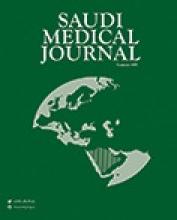Abstract
OBJECTIVE: To report demographic data, etiological spectrum, the varied presentation, certain vascular techniques and their outcome in patients with peripheral vascular trauma.
METHODS: This study included the patients who presented to the emergency room of Jinnah Hospital and Allama Iqbal Medical College Complex, Lahore, Pakistan with acute peripheral vascular injuries from May 1998 to April 2002. The Mangled Extremity Severity Score (MESS) was calculated for each individual to determine the magnitude of injury. A trauma database was devised to analyze each patient's characteristics, time since the injury, etiology of trauma, clinical presentation, associated injuries, surgical procedures performed and the result.
RESULTS: Fifty-seven individuals were managed. The male to female ratio was 49:8 with an age range of 6-69 years (mean 29.1). The time since injury ranged 3-19 hours (mean 9.3). Thirty-one (54.3%) cases sustained vascular trauma by firearm, 10 (17.5%) by blunt trauma, 7 (12.2%) stabs, 6 (10.5%) machinery work and 3 (5.2%) by crush injury. Arterial bleeding from the wound was the most frequent presentation found in 18 (31.5%) patients followed by absent distal pulses recorded in 13 (22.8%) subjects. Fifty-one (89.5%) patients presented with arterial, 6 (10.5%) venous and 9 (15.7%) of these had concomitant arterial and venous injuries. Complete vascular transaction was the most common operative finding noted in 26 (45.6%) cases followed by partial tear in 23 (40.3%) subjects. Fifteen (29.4%) common femoral, 10 (19.6%) brachial, 9 (17.6%) superficial femoral, 7 (13.7%) axillary, 5 (9.8%) popliteal and 4 (7.8%) radial arteries were traumatized. The interposition vein graft was used in 21 (41.1%) cases while primary vascular repair was carried out in 19 (37.2%) patients. Forty-five (78.9%) subjects had a functional limb after vascular reconstruction. Wound infection was recorded in 7 (12.2%) individuals. Six (10.5%) amputations were carried out, all with an average MESS of 7.8 +/- 1. 3 (p<0.05). Three patients died within 10 hours of injury due to torrential hemorrhage.
CONCLUSION: Prompt surgical intervention, frequent use of saphenous vein graft and a low threshold for fasciotomy contributes to a successful outcome in patients with extremity vascular trauma.
- Copyright: © Saudi Medical Journal
This is an open-access article distributed under the terms of the Creative Commons Attribution-Noncommercial-Share Alike 3.0 Unported, which permits unrestricted use, distribution, and reproduction in any medium, provided the original work is properly cited.






